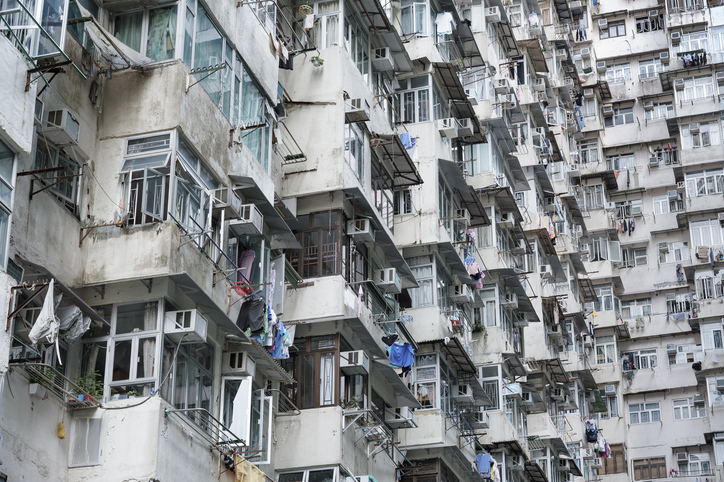Meritas is an international alliance of over 180 business law firms in over 90 countries.
- Home
- About Us
- Our Practices
- Banking and Finance
- Capital Markets
- China Trade and Investment
- Competition
- Compliance and Regulatory
- Corporate and M&A
- Debt Capital Market
- Employment
- Insolvency and Restructuring
- Insurance
- Intellectual Property
- Litigation and Dispute Resolution
- Notarization, Attestation and Marriage Solemnization
- PE Funds and Start-Ups
- Private Wealth & Family Offices
- Real Estate and Tenancy
- Technology, Media and Telecommunications
- Wills, Probate & Trust
- Meritas
- Our Professionals
- Our Offices
- Careers
- News

OWNERSHIP AND MAINTENANCE LIABILITY OF EXTERNAL WALL OF BUILDING
February 2023
The recent Court of Appeal’s decision Donora Company Limited v. The Incorporated Owners of Tsuen Kam Centre HKCU 174 [2023] leads to reconsideration of the relationship between the ownership and maintenance liability of the external wall of a building. Whether the external wall forms part of the common parts of the building is always a starting point. The statutory definition of “common parts” under the Building Management Ordinance is (a) the whole of the building except such parts as have been specified or designated in an “instrument” registered in the Land Registry as being for the exclusive use, occupation or enjoyment of an owner and (b) unless so specified or designated, those parts specified in the First Schedule to the Ordinance. That said, in the external wall analysis, it is always a rational understanding that the “instrument” under the BMO refers to a Deed of Mutual Covenant which serves the function of designating the common parts of a building.
The DMC in Dorona failed to mention that any owner had an exclusive use, occupation or enjoyment of the external wall of the building and the Lands Tribunal thus ruled that no such instrument as prescribed under the BMO existed, thus rendering the external wall of the building to form part of the common parts of the building.
The Court of Appeal reversed the Lands Tribunal’s decision and ruled that the instrument under the DMC could be any document registered in the Land Registry and the First Assignment which reserved the right to the developer to the use, occupation and enjoyment of the external wall of the building could be the instrument under the BMO. As such, the maintenance liability of the external wall should vest in the developer.
While Dorona appears to rule on the interpretation of the BMO and title documents, it has not addressed:
(i) Who actually used the external wall of the building over the years? The Incorporated Owners or any other co-owners?
(ii) How if the developer, though reserved the right, had never exercised such right towards the external wall?
(iii) Who repaired and maintained the external wall in the past years? Who paid the costs?
(iv) Any conduct of the parties which might lead to waiver or acquiescence of such right?
Dorona is obviously not conclusive and the distinct facts of each individual case should be saliently considered to determine who should be liable for the weighted burden to maintain the external wall.

Gallant and Guantao & Chow (“Guantao Hong Kong”) in Association
What Law Firms Can Do to Mitigate Their Cyber Risk
THE LAW SOCIETY 2023 PRO BONO AND COMMUNITY SERVICE AWARD
GALLANT WELCOMED VISIT BY GRASSROOT FAMILIES
THE COURT’S PARAMETER TO PROPOUND AN IMPERFECT WILL
GALLANT MANAGING PARTNER, PHILIP WONG AND HEAD OF REAL ESTATE DEPARTMENT, ANNIE WONG, NAMED A “VISIONARY” IN THE A-LIST LAWYER 2023 BY CHINA BUSINESS LAW JOURNAL
A Roadmap to Personal Data Protection & Privacy in Asia
GALLANT RECOMMENDED IN THE LEGAL 500 ASIA PACIFIC 2024
How Lawyers Can Embrace Generative AI
Gallant’s Managing Partner Attending Meritas Asia Regional Meeting in Sri Lanka
GALLANT RECOGNIZED BY ASIALAW 2023
PRESENTATION OF THE GALLANT PRIZE IN INTRODUCTION TO PRC LAW FOR 2022-2023 AT THE LAW FACULTY OPENING CEREMONY OF THE UNIVERSITY OF HONG KONG
GALLANT HAS BEEN SHORTLISTED FOR ALB HONG KONG LAW AWARDS 2023
GALLANT RECOGNIZED BY IFLR1000 (2023)
GALLANT PREPARING SOFT MEAL FOR ELDERLY
“Hot Take” on Artificial Intelligence
Gallant Managing Partner Mr. Philip Wong Elected to Board of Directors of Meritas Global Alliance of Law Firms
GALLANT RECOGNIZED BY BENCHMARK LITIGATION ASIA-PACIFIC 2023
MERITAS IS RECOGNISED AS AN ELITE GLOBAL LEGAL NETWORK IN CHAMBERS GLOBAL GUIDE 2023
Gallant Shares their Insights on “Law Firm Succession Planning” and “The Growth Potential for Hong Kong Limited Partnership Funds” on Hong Kong Lawyer
GALLANT PRESENTS “HONG KONG: THE LEGAL 500 BANKING & FINANCE – COUNTRY COMPARATIVE GUIDES 2023”
Gallant Distributed Good Luck Bags to the Elderlies
GALLANT RECOMMENDED IN THE LEGAL 500 ASIA PACIFIC 2023
GBA LAWYER’S LICENSE HAS BEEN ISSUED TO A GALLANT SOLICITOR
PHILIP WONG, MANAGING PARTNER OF GALLANT, RECOGNISED AS A-LIST LAWYER 2022 BY CHINA BUSINESS LAW JOURNAL
Gallant proudly celebrates 45 years in Hong Kong
THE LAW SOCIETY 2022 PRO BONO AND COMMUNITY SERVICE AWARD
Partners’ Retreat 2022
PARTNERS AND CONSULTANTS THANKSGIVING 2022
2022 NEWLY ADMITTED SOLICITORS
GALLANT MANAGING PARTNER APPOINTED A JUDGE FOR 21st KINGFISHER ALB HONG KONG LAW AWARDS 2022
PRESENTATION OF THE GALLANT PRIZE IN INTRODUCTION TO PRC LAW FOR 2021-2022 AT THE LAW FACULTY OPENING CEREMONY OF THE UNIVERSITY OF HONG KONG
GALLANT RECOGNIZED BY IFLR1000 (2022)
Asia - A Legal Guide for Business Investment and Expansion
GALLANT RECEIVES CHINA BUSINESS LAW AWARDS 2022
NFTs and Fraud
GALLANT RECOMMENDED BY IFLR1000 (2022) (BANKING AND FINANCE)
GALLANT RECOGNIZED BY BENCHMARK LITIGATION ASIA-PACIFIC 2022
A GLANCE OF THE TEMPORARY PROTECTION MEASURES FOR BUSINESS TENANTS (COVID-19 PANDEMIC) BILL
Philip Wong, Managing Partner of Gallant, Recognised as A-List Lawyer 2021 by China Business Law Journal
GALLANT RECOMMENDED IN THE LEGAL 500 ASIA PACIFIC 2022
WE ARE PROUD MEMBERS OF MERITAS LAW FIRMS WORLDWIDE IN HONG KONG
GALLANT WINNING AT HONGKONG LAND GOLF DAY 2021
2021 NEWLY ADMITTED SOLICITORS STAYING WITH GALLANT
THE FUTURE OF LAWYERING – THE MILLENNIAL PERSPECTIVE
MERITAS YOUNG LAWYERS' VIDEO (ASIA) – EPISODE 3
HKEX published Consultation Paper on SPACs
PRESENTATION OF THE GALLANT PRIZE IN INTRODUCTION TO PRC LAW FOR 2020-2021 AT THE LAW FACULTY OPENING CEREMONY OF THE UNIVERSITY OF HONG KONG
FAR-REACHING IMPLICATIONS OF COURT OF APPEAL’S RULING ON VOLUNTARY ARRANGEMENT BETWEEN BENEFICIARIES ON DISTRIBUTION OF ESTATE
GALLANT INTERVIEWED BY CAIXIN
MERITAS YOUNG LAWYERS' VIDEO (ASIA) – EPISODE 2
GALLANT Attending Cross-Border Conversation: The Challenges Faced by In-House and External Counsel Today
Gallant Interviewed by BioWorld
Building Shanghai Global Asset Management Center - Further Expansion of the QFLP Pilot Program
The Main Board Profit Requirement
HKEX Considers Introducing SPAC
GALLANT RECEIVES CHINA BUSINESS LAW AWARDS 2021
GALLANT RECOGNIZED BY BENCHMARK LITIGATION ASIA-PACIFIC 2021
Client Service Excellence Award 2021 to Gallant
New Initiative Launched To Expedite Lease Modifications - Involving Industrial Buildings
New Managing Partner
Deal or No Deal - Brexit and its Impact on Employers and Their Work Force
Combating the second wave in COVID cases across Europe: Restrictions in place and new support measures for companies and employees
Fintech Development as a Result of the Pandemic and Regulation as the Driving Force of the Fintech Environment
GALLANT RECOGNIZED BY IFLR1000
THE NEW LIMITED PARTNERSHIP FUND ORDINANCE IN HONG KONG
Restructuring Insolvent Airlines in the Americas: A Look at LATAM and developments with AeroMexico and Avianca
ASIALAW REGIONAL AWARDS 2020
How to Protect Against Cybersecurity Threats in a Work-from-Home Environment
WHETHER SERVICE AGREEMENTS ENTERED INTO BY DATA CENTRE OPERATORS MAY CREATE LANDLORD AND TENANT RELATIONSHIP
The Challenges of Data Protection and Privacy During and After the Covid-19 Pandemic
GALLANT RECOGNIZED BY BENCHMARK LITIGATION ASIA-PACIFIC 2020
How Covid-19 Will Trigger Global Supply Chain Realignment
Winning China Business Law Journal Awards 2020
GLOBAL LAW FIRM NETWORK MERITAS NAMES NEW PRESIDENT
Winning China Business Law Journal Deals of the Year 2019
THE LAW SOCIETY 2019 PRO BONO AND COMMUNITY WORK AWARD PRESENTATION CEREMONY
LATEST DEVELOPMENTS IN INSURANCE LAW
GALLANT ATTENDED THE MERITAS 2019 ASIA REGIONAL MEETING
Hongkong Land Golf Day
Hong Kong Court of Appeal Revisits the Rules Concerning Removal of Directors
2019 NEWLY ADMITTED SOLICITORS STAYING WITH OUR FIRM
GALLANT RECOGNIZED BY IFLR1000 2020
GALLANT RECOGNIZED BY ASIALAW PROFILES 2020
PRESENTATION OF THE GALLANT PRIZE IN INTRODUCTION TO PRC LAW FOR 2018-2019 AT THE LAW FACULTY OPENING CEREMONY OF THE UNIVERSITY OF HONG KONG
Seminar to Bank of Communications Co., Ltd. Hong Kong Branch
Mainland China Tightens up Domestic Real Estate Developers' Access to Overseas Financing
GALLANT ACHIEVES GLOBAL CYBERSECURITY STANDARD
GALLANT ATTENDED MERITAS ANNUAL MEETING 2019
O-BANK VISITED GALLANT
FOUNDER OF LEXENCE VISITED GALLANT
Implementation of HKEX’s consultation conclusions on corporate governance
THE LAW SOCIETY 2018 PRO BONO AND COMMUNITY SERVICE AWARD PRESENTATION CEREMONY
Our former Managing Partner and Ex-Board Member of Meritas visited Arnecke Sibeth Dabelstein (“ASD”)
Our Partner and Head of Commercial Department, Philip Wong recognized by China Business Law Journal 2018
The 13th Law & Order Cup
NEWLY ADMITTED SOLICITORS STAYING WITH OUR FIRM
HKEX’S CONSULTATION CONCLUSIONS ON REVIEW OF CORPORATE GOVERNANCE CODE AND GUIDANCE FOR BOARDS AND DIRECTORS
BANK FOUND OWING NO DUTY TO ADVICE TO CUSTOMERS IN HIGH RISK INVESTMENTS
GALLANT RECOGNIZED by IFLR1000 2019
LEGAL NEWS UPDATE: SHOULD REDEVELOPMENT POTENTIAL OF ADJOINING LOTS ON A MERGED SITE BASIS BE CONSIDERED IN DETERMINING COMPULSORY SALE APPLICATION?
GALLANT RECOGNIZED BY ASIALAW PROFILES 2019
THE LATEST MERITAS GUIDE -- A GLOBAL ROADMAP TO PERSONAL DATA PROTECTION: ASIA PACIFIC, EUROPE & USA
Meritas -- a Global Elite Network
Our Consultant, Mr LO Wing-sang, Vincent, BBS, JP, has been awarded the Silver Bauhinia Star
GALLANT ATTENDED MERITAS ANNUAL MEETING 2018
CARING COMPANY PARTNERSHIP EXPO 2018
SEMINAR TO BANK OF CHINA LIMITED, MACAU BRANCH
A Legal Guide for Business Investment and Expansion: Hong Kong
DIRECTOR OF FAIRFIELD AND WOODS VISITED GALLANT
CHINA BUSINESS LAW AWARD 2017-18
Final Appeal Allowed in Lo Siu Wa v. Employees Compensation Assistance Fund Board & Anor [2018] HKCFA 3
Does bank owe duty of care to applicant of injunction order?
SENIOR PARTNER OF PEPELIAEV GROUP VISITED GALLANT
Gallant 40th Anniversary
Newly admitted solicitors staying with our firm (2017)
Gallant recognized by Asialaw Profiles 2018
Can banks still rely on non-reliance clauses in transactions without "suitability clause" ?
MR. ELI BARASCH, HEAD OF CHINA DESK OF MERITAS FIRM IN ISRAEL, VISITED GALLANT
Seminar on SFC’s Code of Conduct
Seminar to Bank of China Limited Guangdong Branch on Cross-border Banking and Enforcement of Security
Meritas Asia Regional Retreat and Board of Directors Meeting
Four newly admitted solicitors staying with our firm
Greater China Legal Affairs Committee Annual Brainstorming Session
Hong Kong Chinese Civil Servants’ Association 21st Century Inauguration Ceremony of Council Members for the 6th Term (2015-2018) Cum 2016 Annual Member’s Banquet
Certificate of Appreciation awarded by The Hong Kong Society for the Aged
Meritas Recertification 2015
Seminar to Nanyang Commercial Bank, Limited - bank security in relation to book debts
Our Firm has been retained as a Hong Kong legal counsel on a regular retainer basis by a new Japanese client
Our recent publication: Discrimination Law in Hong Kong, Lexis Practical Guidance
Law Society’s Pro Bono and Community Work Recognition Programme 2013 ("the Programme")
Meritas Asia and Australia
Hong Kong Chinese Civil Servants’ Association 21st century - 5th Inauguration of Executive Councillors cum Annual Gathering
Appointment of Member of the Environmental Campaign Committee
SCOLAR and Law Society Volunteer Scheme (2012
Law Society’s Pro Bono and Community Work Recognition Programme 2012 ("the Programme")
Certificate of Appreciation awarded by The Hong Kong Society for the Aged
Guangdong Justice Department visited our firm
Copyright 2024, Gallant All rights reserved.

